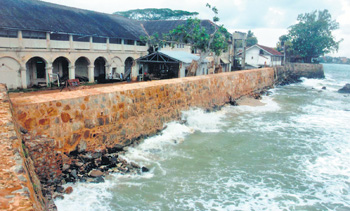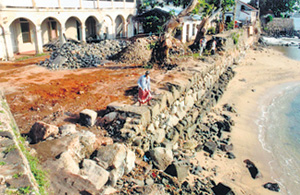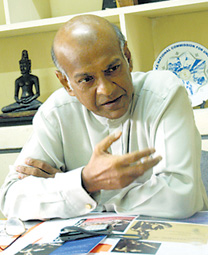
A close encounter with our heritageCCF’s new Director-General Prof. Sudharshan Seneviratne has exciting new plans to expand cultural tourism especially in Galle, Anuradhapura and Polonnaruwa, Kumudini Hettiarachchi reports Underwater exploration to view the shipwrecks strewn along the coast of Galle or a few days of reflection in a Heritage Park in Anuradhapura or Polonnaruwa! These are a few of the plans on the drawing boards of the Central Cultural Fund to lure the “discerning, sophisticated and upmarket” tourist while generating its own funding without milking the Treasury, under the CCF’s new Director-General Prof. Sudharshan Seneviratne who took up the mantle just eight months ago in August 2007. Conceding that the CCF has come to a new phase, after 25 years in existence, he stresses that it is important to take stock of the achievements garnered through the “sweat and tears” of the hundreds of people who have toiled behind the scenes at the six heritage sites of Sigiriya, Dambulla, Anuradhapura, Polonnaruwa, Galle and Kandy to excavate, explore and conserve them. The time has come to look ahead to where “we go from here and what the international implications of cultural tourism are”, while setting in motion programmes to train the next generation to take forward the good work.
Taking up culture at the worst time, with a drop in tourism and a resurgence of the conflict, Prof. Seneviratne who is certainly no armchair archaeologist has been walking a tight rope, with the total income from heritage sites amounting to Rs. 20 million but needing Rs. 40m. plus for salaries only. “The electricity bill alone is about Rs. 9.8 m,” he smiles. For 20-odd years, the CCF had been encouraging cultural tourism at mega sites but serious thought had to be given to what the agenda would be till 2020. With the Board of Governors ratifying infrastructure and institutional development, the CCF is on a new and exciting path today. Whereas UNESCO has been and will be an integral part of CCF planning, The Sunday Times learns that it would seek to broadbase the stakeholders looking not only at the Ministry of Tourism as a valued partner “because culture inexorably coexists with tourism” but also at the private sector urging it to take up projects under its corporate social responsibility initiatives but on the terms laid down by the CCF. “Support from the Tourism Ministry and also Sri Lanka Tourism has been readily forthcoming,” says the Director-General. Passionately, Prof. Seneviratne zeros in on Galle and says that an agreement has been signed last week with UNESCO to set up the Asia-Pacific School of Underwater Archaeology at the historic Galle Fort. It is to be a training centre but the CCF’s vision goes way beyond – to develop it as a centre of excellence not only for archaeology but also for oceanography tackling issues such as pollution and linking up with global universities. Already a 15-member core group of trainers has undergone a course in underwater tourism under the able direction of newly-appointed Deputy Director-General Dr. Mohan Abeyratne. That’s not all for Galle. With the generous help of the Netherlands Ambassador Reynout van Dijk, a Marine Archaeology Museum and also a Marine Biology Museum will see the light of day as will archaeological sites along the southern belt from Galle to Kataragama where the first multi-religious museum will be set up. “The Galle Marine Archaeology Museum will have a hall specially designated for cultural and literary activity,” says Prof. Seneviratne appreciating the support of Southern Province Governor Kumari Balasuriya. And in keeping with its history, the CCF hopes to team up with the Galle Heritage Foundation and hoteliers to “work” the streets in the Fort to bring about a touch of the past by making them cobbled streets as in Dutch times. The Dutch government, it is learnt, has sponsored the cleaning up of the warehouses and bastions of the ramparts. “It was so exciting when my people led me through secret tunnels from one level of the ramparts to another,” he says, adding that walk tours will be exciting for the tourists who will be able to wend their way through these ancient tunnels, and take a peek at the prison, the magazine room and also see the rotating gun carriages used in World War II. They will get a view of the Portuguese, Dutch and British occupations of Galle.
From Galle, the Director-General expands to Anuradhapura and Polonnaruwa, the cradle of civilization in Lanka and his hopes of making these ancient cities not just a three or four-hour stop for the tourist. Heritage Parks, a first for the country, away from the mega sites of these cities are his answer to making them stay and be part of the enriching culture. Anuradhapura’s Heritage Park will extend from Ranmasu Uyana (water-garden) to Isurumuniya, Vessagiriya and Dakkina stupa but with no intrusive developments, only landscaping of the area and cleaning up of the natural ponds. “These will be beautiful parks where people will be able to spend time reflecting or even meditating while looking on the skills of crafts people at work or children painting, away from the hustle and bustle. Most tourists will pay a lot for such special memories,” he is sure. In Polonnaruwa, the park will cover the Nissanka Palace and water garden, resthouse and museum. A bird park will be set up by the old rest house road and the two islands in the Parakrama Samudra developed so that people can go there by boat. The other ambitious plans include the development of the heritage sites as research portals for those interested, with CCF as the partner and under strict guidelines and development of a big digital centre in Kandy, chosen because it is centrally located and climatically suitable, with links to prestigious museums and universities worldwide. “The huge reservoir of information on our heritage sites will be available then at the touch of a button,” explains Prof. Seneviratne. The currently low-key Artifacts Replica Centre at Bataleeya is to be taken to greater heights upgraded as a hub where cultural events such as artifact fairs will take place where the tourist will be able to sit by the side of an artisan and see a replica take shape.
The CCF is hoping to have a “blast” at the end of September- early October at the Art Gallery in Colombo to bring these crafts people to the limelight while also providing a glimpse of what happens everyday at Bataleeya. Detailing the other activities planned, he reveals that Seruwila has been sent for nomination as a Heritage Site, with the personal efforts of Chief Justice Sarath N. Silva. Seruwila, Somawathie, Mahiyanganaya and Kandy, all along the Mahaweli, will form the “Buddha relic square” while port and Hindu sites such as Koneshwaram and Thiruketishwaram will also be excavated, explored and conserved as will be the eastern belt multi-religious sites. “Culture is all-inclusive,” he says bringing hope to a country where divisions have been tearing it asunder. For Kandy, where in 2006 cultural mapping identified 400-odd heritage monuments but now has only 200 as most of them have been torn down and replaced by shops, a Heritage Plan is in the making to set off a Monitoring, Maintenance and Training Process for staff, with the assistance of the Professional Organization and the Nature Society. As the CCF looks to the future with new vigour, the next goal is to reach the Heritage Tourism Initiative by working towards carbon-free heritage sites by cutting down on vehicle emissions and other factors which affect the environment. Showcasing CCF’s best The Central Cultural Fund, the custodian for World Heritage Sites, will hold Heritage Achievements 2007 on April 24 at the Sri Lanka Foundation Institute. The day will showcase six programmes undertaken in archaeological and conservation performances in 2007. They are:
These presentations establish benchmark programmes to be emulated and improved in the coming years, Prof. Seneviratne said. Hitherto unseen images of the 1998 cultural carnage by terrorists on the Temple of the Tooth Relic and its subsequent rise from the ashes due to the efforts of CCF’s young conservators will also be featured, it is learnt. Commending the CCF’s conservators, the Director-General said most of them have toiled for a pittance for love of country and culture without seeking greener pastures. They are the children of the soil. They are like flowers in the forest which bloom and wither unappreciated. Through the Heritage Achievements I am showing them off, he says adding unabashedly that he is first a teacher, then archaeologist and only finally heritage bureaucrat. |
|
||||||
|| Front
Page | News | Editorial | Columns | Sports | Plus | Financial
Times | International | Mirror | TV
Times | Funday
Times || |
| |
Reproduction of articles permitted when used without any alterations to contents and a link to the source page.
|
© Copyright
2008 | Wijeya
Newspapers Ltd.Colombo. Sri Lanka. All Rights Reserved. |


